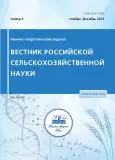The influence of low-intensity laser radiation on the blood parameters of cows under technological stress
- Authors: Deryuginа A.V1, Ivashchenko M.N2, Talamanova M.N1, Petrov V.A2, Erobkina D.A1, Kustova A.A1
-
Affiliations:
- National Research Nizhny Novgorod State University named after N.I. Lobachevsky
- Nizhny Novgorod State Agrotechnological University
- Issue: No 6 (2023)
- Pages: 95-99
- Section: Articles
- URL: https://journals.rcsi.science/2500-2082/article/view/233593
- DOI: https://doi.org/10.31857/2500-2082/2023/6/95-99
- EDN: https://elibrary.ru/WRHFAI
- ID: 233593
Cite item
Full Text
Abstract
About the authors
A. V Deryuginа
National Research Nizhny Novgorod State University named after N.I. Lobachevsky
Email: kafedra2577@mail.ru
M. N Ivashchenko
Nizhny Novgorod State Agrotechnological University
M. N Talamanova
National Research Nizhny Novgorod State University named after N.I. Lobachevsky
V. A Petrov
Nizhny Novgorod State Agrotechnological University
D. A Erobkina
National Research Nizhny Novgorod State University named after N.I. Lobachevsky
A. A Kustova
National Research Nizhny Novgorod State University named after N.I. Lobachevsky
References
- Высокогорский В.Е., Ефременко Е.С., Грицаев И.Е. Характеристика обмена глутатиона при алкогольном абстинентном синдроме // Наркология. 2006. №56(8). С. 59-61.
- Голубева М.Г. Влияние физической нагрузки на функциональное состояние мембран эритроцитов // Спортивная медицина: наука и практика. 2020. №10 (2). С.55-64. doi: 10.17238/ISSN2223-2524.2020.2.55.
- Кудряшов А.М., Титова Н.М., Кудряшова Е.В. Влияние поллютантов с различными стресс-характеристиками на антиоксидантный статус эритроцитов in vitro // Экология человека. 2005. №1. С. 14-18. doi: 10.25750/1995-4301-2020-3-006-014.
- Кулинский В.И. Колесниченко Л.С. Система глутатиона. I. Синтез, транспорт, глутатионтрансферазы, глутатионпероксидазы // Биомед. химия. 2009. №55(3). С. 255-277. doi: 10.1134/S1990750809020036.
- Нестеров Ю.В. Морфофизиологические показатели эритроцитов при оксидативном стрессе на разных этапах онтогенеза // Живые и биокосные систем. 2015. №11. URL: http://www.jbks.ru/archive/issue-11/article-5.
- Нечипуренко Н.И., Пашковская И.Д., Степанова Ю.И. Механизмы действия и биологические эффекты низкоинтенсивного лазерного излучения // Медицинские новости. 2008. №12. С. 17-21.
- Осочук, С.С. Марцинкевич А.Ф. Физико-химические свойства мембран эритроцитов спортсменов циклических видов спорта // Вестник ВГМУ. 2013. №12(3). С. 25-31.
- Прохоренко П.Н. Методы повышения генетического потенциала продуктивности и его реализация в молочном скотоводстве // Журнал Вестник ОрелГАУ. 2008. №2(18). С. 11-13.
- Чуян Е.Н. Физиологические механизмы биологических эффектов низкоинтенсивного ЭМИ КВЧ. Симферополь: Эльиньо, 2003. 448 с.
- Шамонина А.И. Влияние стресса на молочную продуктивность первотелок // Зоотехническая наука Беларуси. 2021. №56 (2). С. 261-268.
- Шумилова А.В., Дерюгина А.В., Гордлеева С.Ю., Бояринов Г.А. Действие цитофлавина на электрокинетические и агрегационные показатели эритроцитов в посттравматический период черепно-мозговой травмы в эксперименте // Экспериментальная и клиническая фармакология. 2018. Т.81. №3. С. 20-23.doi: 10.30906/0869-2092-2018-81-3-20-23.
- Эйдус Л.Х. Мембранный механизм биологического действия малых доз. Новый взгляд на проблему. М., 2001. 81 с.
- Alves A. C., Vieira R., Leal-Junior E. et al. Effect of lowlevel laser therapy on the expression of inflammatory mediators and on neutrophils and macrophages in acute joint inflammation // Arthritis Res. Ther. 2013. №15 (5). P. 116 doi: 10.1186/ar4296.
- Banfi G. Dolci A., Schonhuber H., Costantino B. Values of the parameter IRF in elite athletes // Clin Lab Haematol. 2004. №26(3). Р. 241-244. doi: 10.1111/j.1365-2257.2004.00610.x.
- Deryugina A.V., Ivashchenko M.N., Samodelkin A.G. et al. Low-level laser therapy as a modifier of erythrocytes morphokinetic parameters in hyperadrenalinemia // Lasers in Medical Science. 2019. №34(8). С. 1603-1612. doi: 10.1007/s10103-019-02755-.y
- Ellman G.L. Tissue sulfliydryl groups // Arch. Biochem. Biophys. 1959. Vol.82. №.l. P. 70-77.
- Lyles J.L., Calvo-Lorenzo M.S., Bill E. Kunkle Interdisciplinary Beef Symposium: Practical developments in managing animal welfare in beef cattle: What does the future hold? // J. Anim. Sci. 2014. № 9. P. 5334-5344. doi: 10.2527 /jas.2014-8149.
- Mantovani G., Maccio A., Madeddi C. Reactive oxygen species, antioxidant mechanisms and serum cytokine lrvels in cancer patients: impact of an antioxidant treatment // J. Cell. Mol. Med. 2002. №6(6). P. 570-582. doi: 10.1111/j.1582-4934.2002.tb00455.x.
- Tintinger G.R., Theron A.J., Anderson R., Ker J.A. The Anti-Inflammatory Interactions of Epinephrine with Human Neutrophils in vitro Are Achieved by Cyclic AMP-Mediated Accelerated Resequestration of Cytosolic Calcium // Biochem. Pharmacol. 2001. Vol. 61. № 10. Р. 1319-1328. doi: 10.1016/s0006-2952(01)00588-3
- Woo A.Y., Song Y., Xiao R.P., Zhu W. Biased ß2-Adrenoceptor Signaling in Heart Failure: Pathophysiology and Drug Discovery // Br. J. Pharmacol. 2015. Vol. 172. № 23. P. 5444-5456. doi: 10.1111 /bph.12965.
Supplementary files










